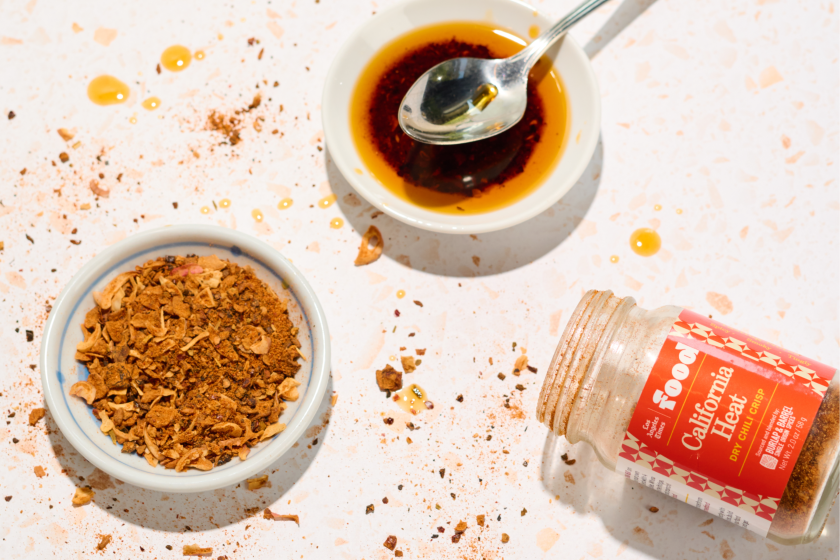Fresh beet-ginger raita
- Share via
INDIAN breads, collectively called rotis, have become extremely popular restaurant items in the U.S. They are eminently doable at home as well.
The breads as we know them here are from central and northern India, where mostly wheat is grown. In those regions, rice may be eaten, but meals are always centered around fresh homemade breads. In southern, western and eastern India as well as in pockets up north, rice is the staple, but breads are becoming popular throughout the country, albeit in local interpretations.
I find a dazzling array of possibilities greets me when I go to India: essential chapatis, luxurious parathas (plain and stuffed), festive puris and elegant nans (just buttered or stuffed). Within these four main categories are a variety of improvisations too numerous to mention. (I am often asked whether pappadums and dosas are breads. I would categorize the former as lentil wafers served with condiments and the latter as cr?pes; not the staff of life but, rather, elegant accessories.)
All rotis are unleavened flatbreads, the exception being tandoori nans, which are commercially prepared yeast breads, but even these are always flat, albeit fluffy and light as air. Western-style bakery breads, called double rotis (presumably for the two risings of the dough), and tandoori nans are available only at restaurants and cafes, for the simple reason that hardly any home kitchen in India is equipped with a tandoor, and only a small percentage of yuppie cooks there have Western-type ovens.
Admittedly, in a population base of more than 1 billion, even a small percentage is nothing to sneeze at! But cooking in India typically is a stove-top affair. Of the four main Indian breads, the simplest is the humble chapati, the perfect accompaniment to vegetables, curries and dals (lentils). Puris, deep fried breads that puff up into incredible little round balloons, are at the other end of the spectrum. Festive breads, they are usually eaten with some kind of potato dish, or with sweet sooji (cream of wheat) halva.
For successful chapatis or puris, it’s important to have the right flour and utensils, and to carefully regulate the heat.
The best flour for chapatis and puris is durum atta flour. Also called chapati flour, atta is available in Indian groceries as well as some really eclectic supermarkets. If you must, use regular whole wheat-white flour, not stone-ground (not a choice for those of us who have grown up with the chapati flour), but do not use all-purpose flour. For one, the breads will be inauthentic (only Bengali luchis are made with all-purpose flour); for another, the dough will not roll out the way it should.
In Gujarat state, in western India, they use very slim rolling pins to make paper-thin rotis; up north the pins are of wider diameter and the breads are more robust. The traditional Indian belan is a one-piece tool. When I first arrived in the U.S., a newly minted bride, and tried to use an American rolling pin to make chapatis, the dough refused to budge. Today, although slim, Indian pins also have movable middles.
For both chapatis and puris, make the dough, form it into a log like a cookie roll and set it aside to rest. Then, cut it into portions to make small balls of dough which you will roll out into discs. A griddle is excellent for cooking chapatis; puris are always deep-fried, preferably in a wok.
Indians use a heavy, cast-iron tawa to make breads such as chapatis; it is slightly concave in the middle, a centuries-old design, adapted to live cooking fires. Today, with flat cooking surfaces, a large cast-iron skillet or griddle works beautifully; as my metallurgist husband tells me, it is all about low conductivity.
Whether you’re cooking a batch of chapatis or frying up puris, however, you must bring the griddle or wok to a seasoned good heat. In other words, keep it at medium-high heat for a minute or so before you start cooking. Then regulate up or down to maintain that medium-high heat level to cook the rotis evenly and thoroughly without burning.
Now, recipes, ingredients and utensils in hand, you are on your way. One last word of advice: Make a trial chapati or puri first to make sure cooking temperatures are right.
You could serve the chapatis or the puris with a dry-ish (not too much sauce) vegetable dish such as a crisply fried potato and peas curry; or potato and okra saut?ed with onions and cumin seed; or a channa masala (spiced garbanzo beans) cooked with boiled and quartered potatoes. Add a bowl of cool beet-ginger raita, an incredibly easy to make, colorful concoction of grated vegetables, spices, yogurt and sour cream, and you have a flavorful end-of-summer meal.
Yogurt is an indispensable part of an everyday Indian meal, but this glamorous beet-ginger raita takes yogurt to the level of delicacy. More important, it complements the chapatis and puris to perfection.
Place the beets in a small saucepan of boiling water so they are completely immersed. Cover and cook until they are tender, about 45 minutes. Drain the beets and cool them in a bowl of ice water until cool enough to handle. Peel the beets and dice them into about one-eighth-inch pieces. Place the diced beets in a fine mesh strainer and run them under cool water until the water draining is a pale pink. Drain the beets well.
In a medium bowl, gently mix the beets with the onion, hot green pepper, ginger, salt, cumin, black pepper, cilantro, yogurt and sour cream. Sprinkle a pinch of cilantro on top. Chill and serve.
Get our Cooking newsletter.
Your roundup of inspiring recipes and kitchen tricks.
You may occasionally receive promotional content from the Los Angeles Times.















